Hospitality Finance: Sources of Funding, Cost Control, and Ratios
VerifiedAdded on 2020/06/04
|12
|2914
|33
Report
AI Summary
This report provides a comprehensive overview of financial management within the hospitality industry. It begins by exploring various sources of funding, including personal investment, venture capital, bank loans, and retained earnings, and discusses methods for generating income, such as commission, sales promotion, and sponsorship. The report then delves into cost elements, including material, direct labor, and indirect expenses, and explains gross profit percentages and selling price calculations. Methods for controlling stock and cash are also examined. The report further assesses the structure of a trial balance, measures business accounts, and discusses adjustments and notes. It also covers the process and purpose of budgetary control, including variance analysis. Financial ratios are calculated and analyzed to interpret historical business performance, offering insights into future management strategies. Finally, the report categorizes costs, calculates contribution per product, and discusses short-term management decisions based on profit/loss potential and break-even calculations, ultimately providing a detailed analysis of finance in hospitality.
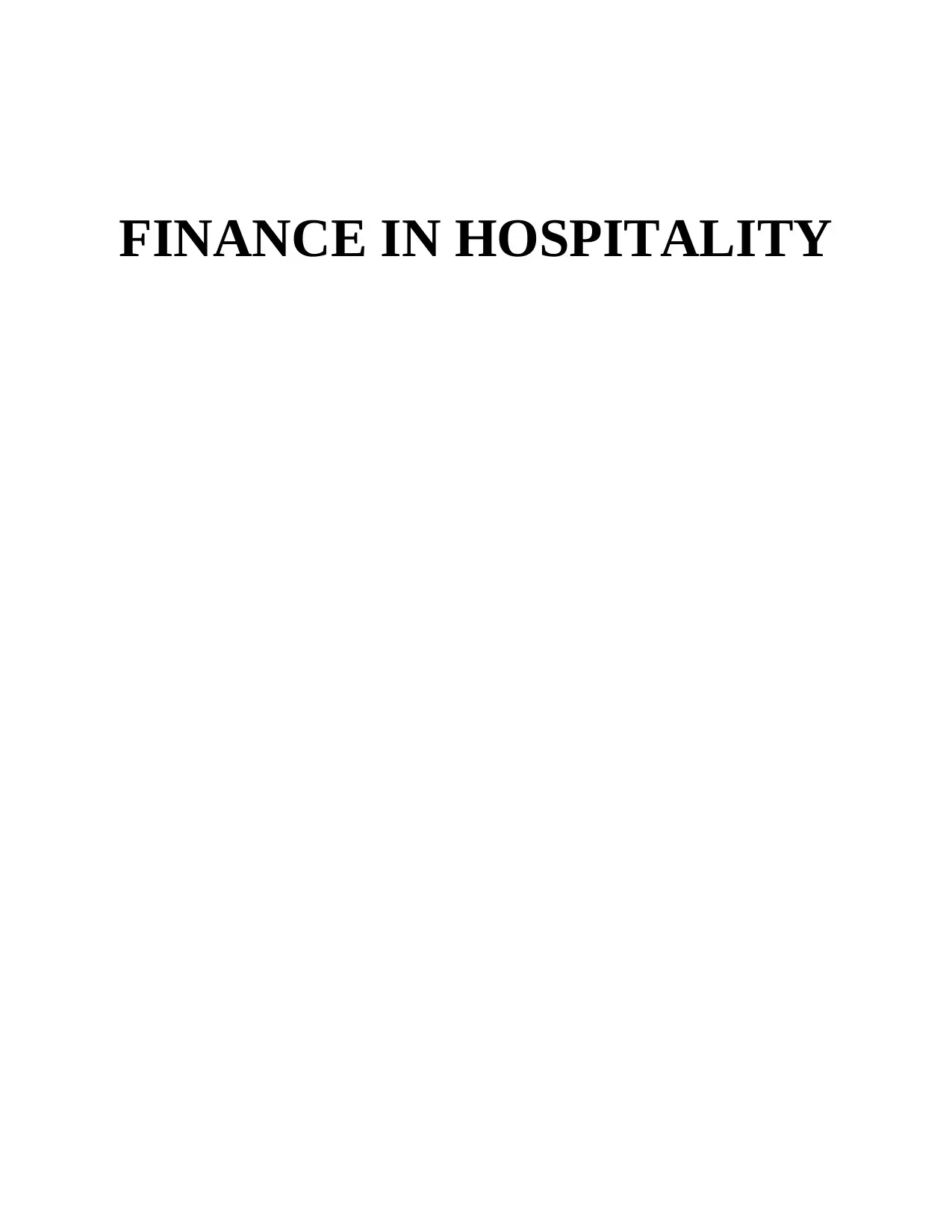
FINANCE IN HOSPITALITY
Paraphrase This Document
Need a fresh take? Get an instant paraphrase of this document with our AI Paraphraser
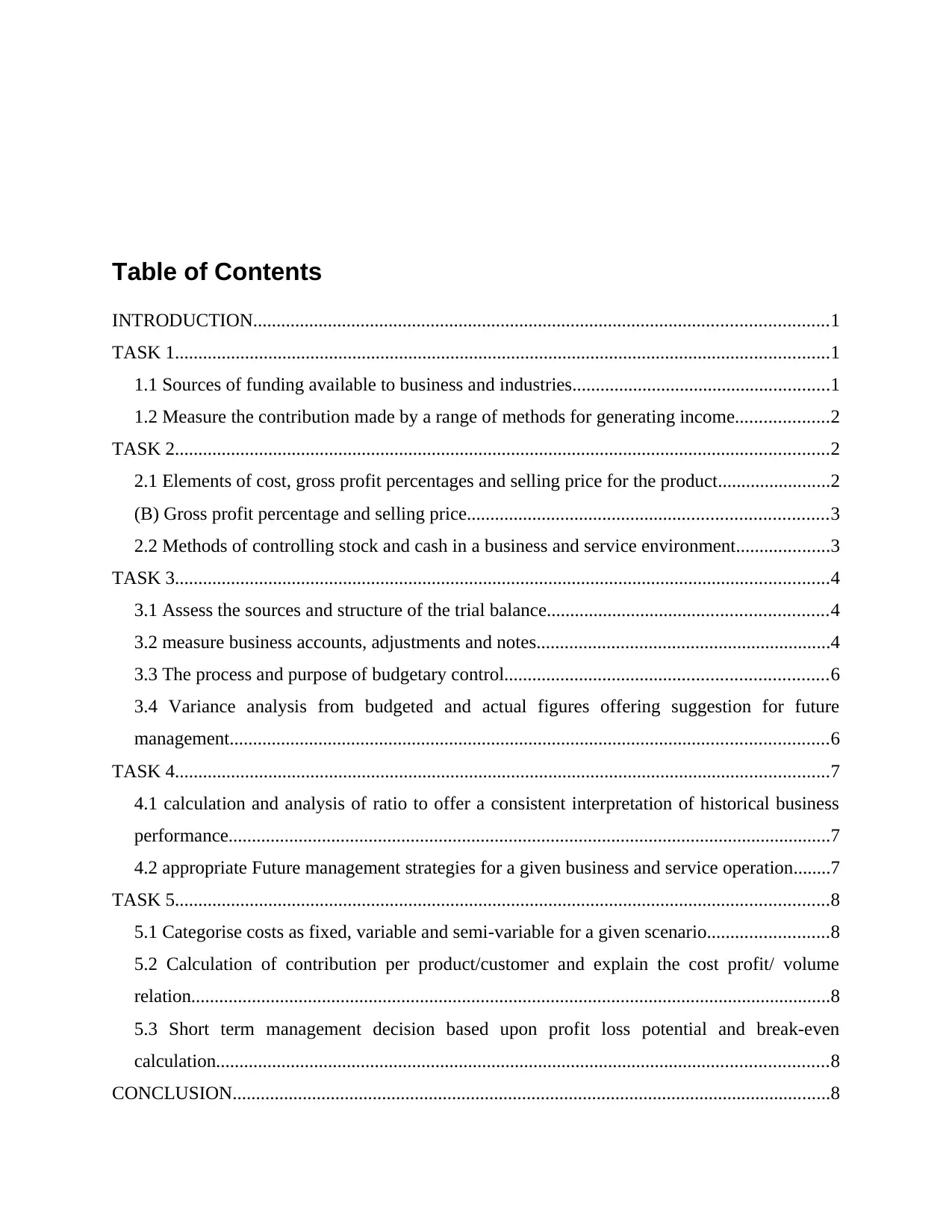
Table of Contents
INTRODUCTION...........................................................................................................................1
TASK 1............................................................................................................................................1
1.1 Sources of funding available to business and industries.......................................................1
1.2 Measure the contribution made by a range of methods for generating income....................2
TASK 2............................................................................................................................................2
2.1 Elements of cost, gross profit percentages and selling price for the product........................2
(B) Gross profit percentage and selling price.............................................................................3
2.2 Methods of controlling stock and cash in a business and service environment....................3
TASK 3............................................................................................................................................4
3.1 Assess the sources and structure of the trial balance............................................................4
3.2 measure business accounts, adjustments and notes...............................................................4
3.3 The process and purpose of budgetary control.....................................................................6
3.4 Variance analysis from budgeted and actual figures offering suggestion for future
management................................................................................................................................6
TASK 4............................................................................................................................................7
4.1 calculation and analysis of ratio to offer a consistent interpretation of historical business
performance.................................................................................................................................7
4.2 appropriate Future management strategies for a given business and service operation........7
TASK 5............................................................................................................................................8
5.1 Categorise costs as fixed, variable and semi-variable for a given scenario..........................8
5.2 Calculation of contribution per product/customer and explain the cost profit/ volume
relation.........................................................................................................................................8
5.3 Short term management decision based upon profit loss potential and break-even
calculation...................................................................................................................................8
CONCLUSION................................................................................................................................8
INTRODUCTION...........................................................................................................................1
TASK 1............................................................................................................................................1
1.1 Sources of funding available to business and industries.......................................................1
1.2 Measure the contribution made by a range of methods for generating income....................2
TASK 2............................................................................................................................................2
2.1 Elements of cost, gross profit percentages and selling price for the product........................2
(B) Gross profit percentage and selling price.............................................................................3
2.2 Methods of controlling stock and cash in a business and service environment....................3
TASK 3............................................................................................................................................4
3.1 Assess the sources and structure of the trial balance............................................................4
3.2 measure business accounts, adjustments and notes...............................................................4
3.3 The process and purpose of budgetary control.....................................................................6
3.4 Variance analysis from budgeted and actual figures offering suggestion for future
management................................................................................................................................6
TASK 4............................................................................................................................................7
4.1 calculation and analysis of ratio to offer a consistent interpretation of historical business
performance.................................................................................................................................7
4.2 appropriate Future management strategies for a given business and service operation........7
TASK 5............................................................................................................................................8
5.1 Categorise costs as fixed, variable and semi-variable for a given scenario..........................8
5.2 Calculation of contribution per product/customer and explain the cost profit/ volume
relation.........................................................................................................................................8
5.3 Short term management decision based upon profit loss potential and break-even
calculation...................................................................................................................................8
CONCLUSION................................................................................................................................8
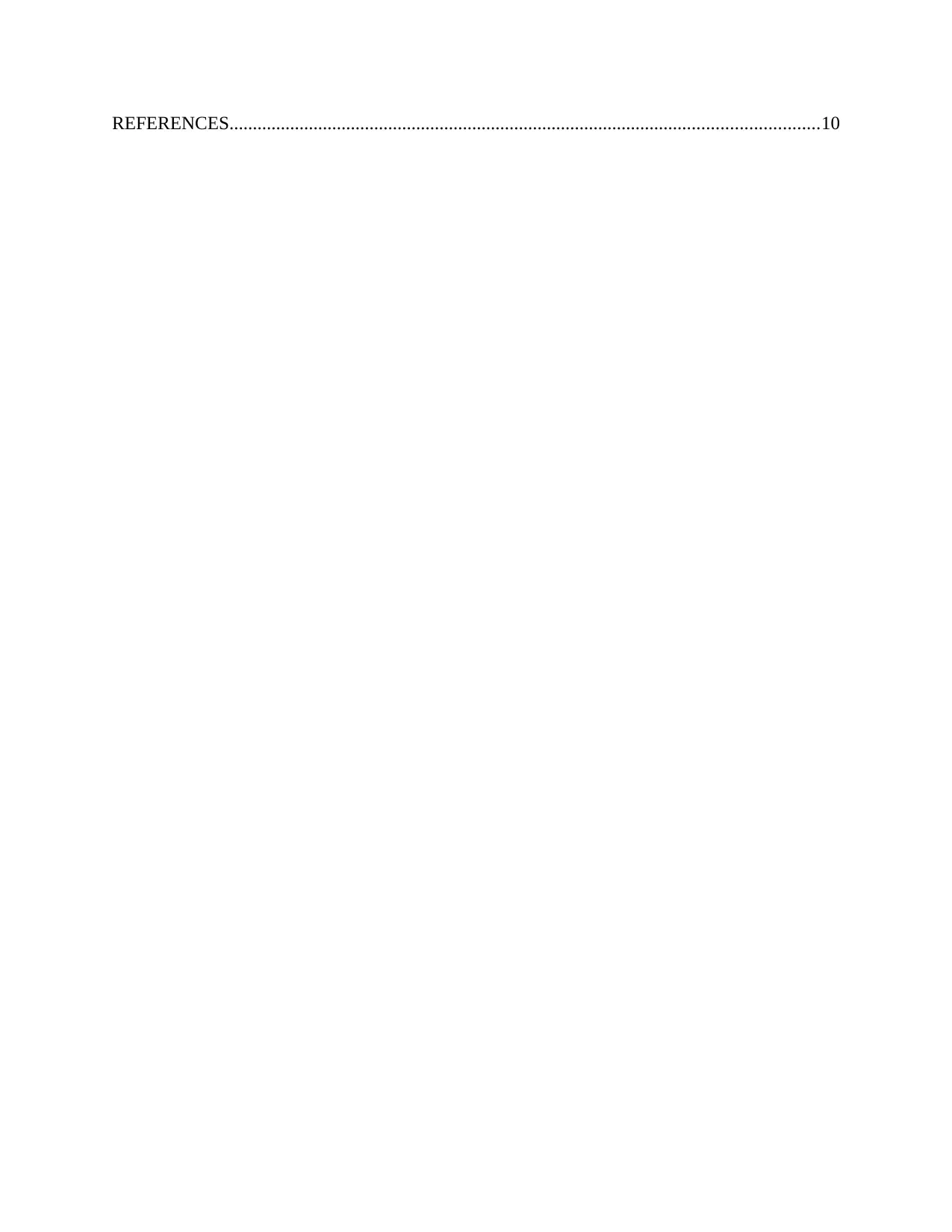
REFERENCES..............................................................................................................................10
⊘ This is a preview!⊘
Do you want full access?
Subscribe today to unlock all pages.

Trusted by 1+ million students worldwide
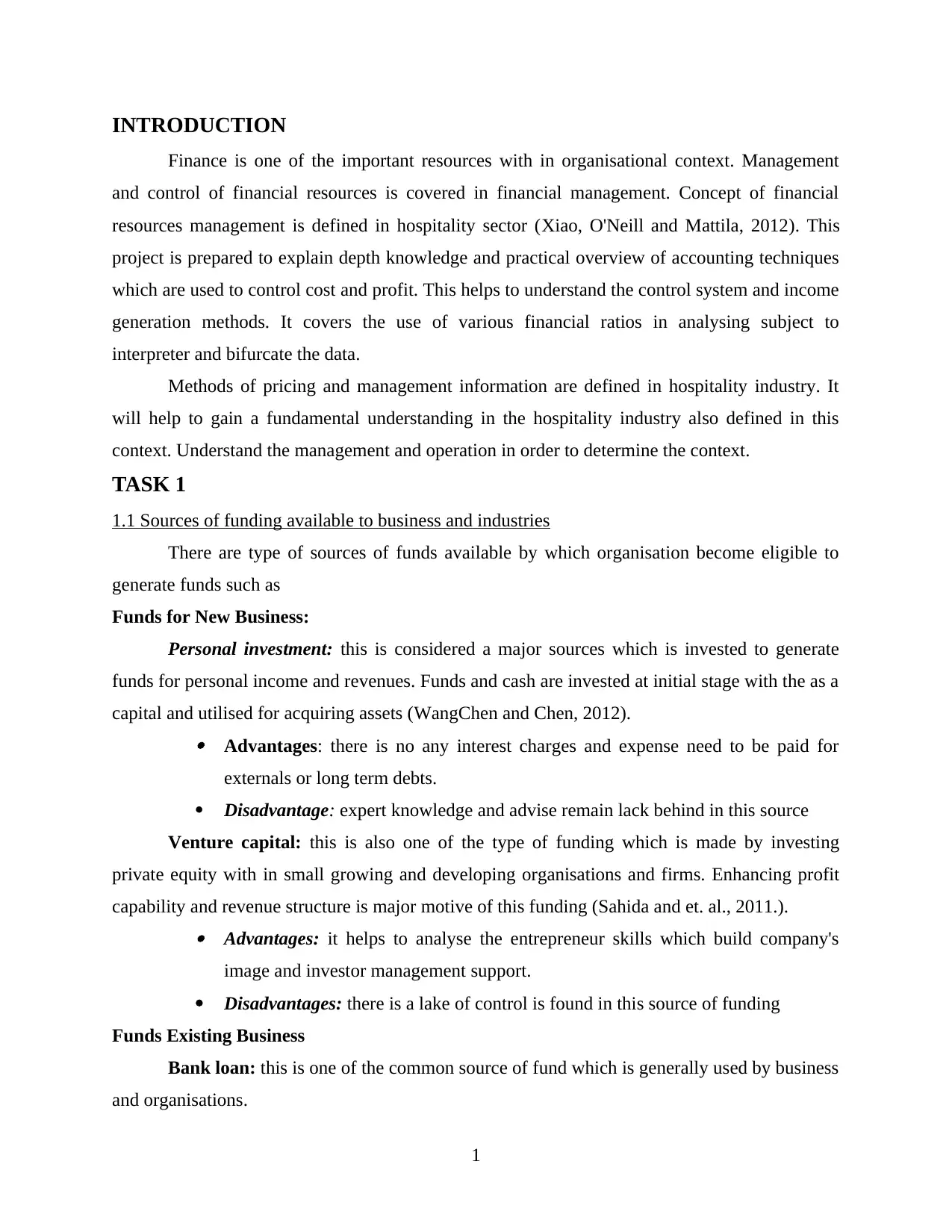
INTRODUCTION
Finance is one of the important resources with in organisational context. Management
and control of financial resources is covered in financial management. Concept of financial
resources management is defined in hospitality sector (Xiao, O'Neill and Mattila, 2012). This
project is prepared to explain depth knowledge and practical overview of accounting techniques
which are used to control cost and profit. This helps to understand the control system and income
generation methods. It covers the use of various financial ratios in analysing subject to
interpreter and bifurcate the data.
Methods of pricing and management information are defined in hospitality industry. It
will help to gain a fundamental understanding in the hospitality industry also defined in this
context. Understand the management and operation in order to determine the context.
TASK 1
1.1 Sources of funding available to business and industries
There are type of sources of funds available by which organisation become eligible to
generate funds such as
Funds for New Business:
Personal investment: this is considered a major sources which is invested to generate
funds for personal income and revenues. Funds and cash are invested at initial stage with the as a
capital and utilised for acquiring assets (WangChen and Chen, 2012).
Advantages: there is no any interest charges and expense need to be paid for
externals or long term debts.
Disadvantage: expert knowledge and advise remain lack behind in this source
Venture capital: this is also one of the type of funding which is made by investing
private equity with in small growing and developing organisations and firms. Enhancing profit
capability and revenue structure is major motive of this funding (Sahida and et. al., 2011.).
Advantages: it helps to analyse the entrepreneur skills which build company's
image and investor management support.
Disadvantages: there is a lake of control is found in this source of funding
Funds Existing Business
Bank loan: this is one of the common source of fund which is generally used by business
and organisations.
1
Finance is one of the important resources with in organisational context. Management
and control of financial resources is covered in financial management. Concept of financial
resources management is defined in hospitality sector (Xiao, O'Neill and Mattila, 2012). This
project is prepared to explain depth knowledge and practical overview of accounting techniques
which are used to control cost and profit. This helps to understand the control system and income
generation methods. It covers the use of various financial ratios in analysing subject to
interpreter and bifurcate the data.
Methods of pricing and management information are defined in hospitality industry. It
will help to gain a fundamental understanding in the hospitality industry also defined in this
context. Understand the management and operation in order to determine the context.
TASK 1
1.1 Sources of funding available to business and industries
There are type of sources of funds available by which organisation become eligible to
generate funds such as
Funds for New Business:
Personal investment: this is considered a major sources which is invested to generate
funds for personal income and revenues. Funds and cash are invested at initial stage with the as a
capital and utilised for acquiring assets (WangChen and Chen, 2012).
Advantages: there is no any interest charges and expense need to be paid for
externals or long term debts.
Disadvantage: expert knowledge and advise remain lack behind in this source
Venture capital: this is also one of the type of funding which is made by investing
private equity with in small growing and developing organisations and firms. Enhancing profit
capability and revenue structure is major motive of this funding (Sahida and et. al., 2011.).
Advantages: it helps to analyse the entrepreneur skills which build company's
image and investor management support.
Disadvantages: there is a lake of control is found in this source of funding
Funds Existing Business
Bank loan: this is one of the common source of fund which is generally used by business
and organisations.
1
Paraphrase This Document
Need a fresh take? Get an instant paraphrase of this document with our AI Paraphraser
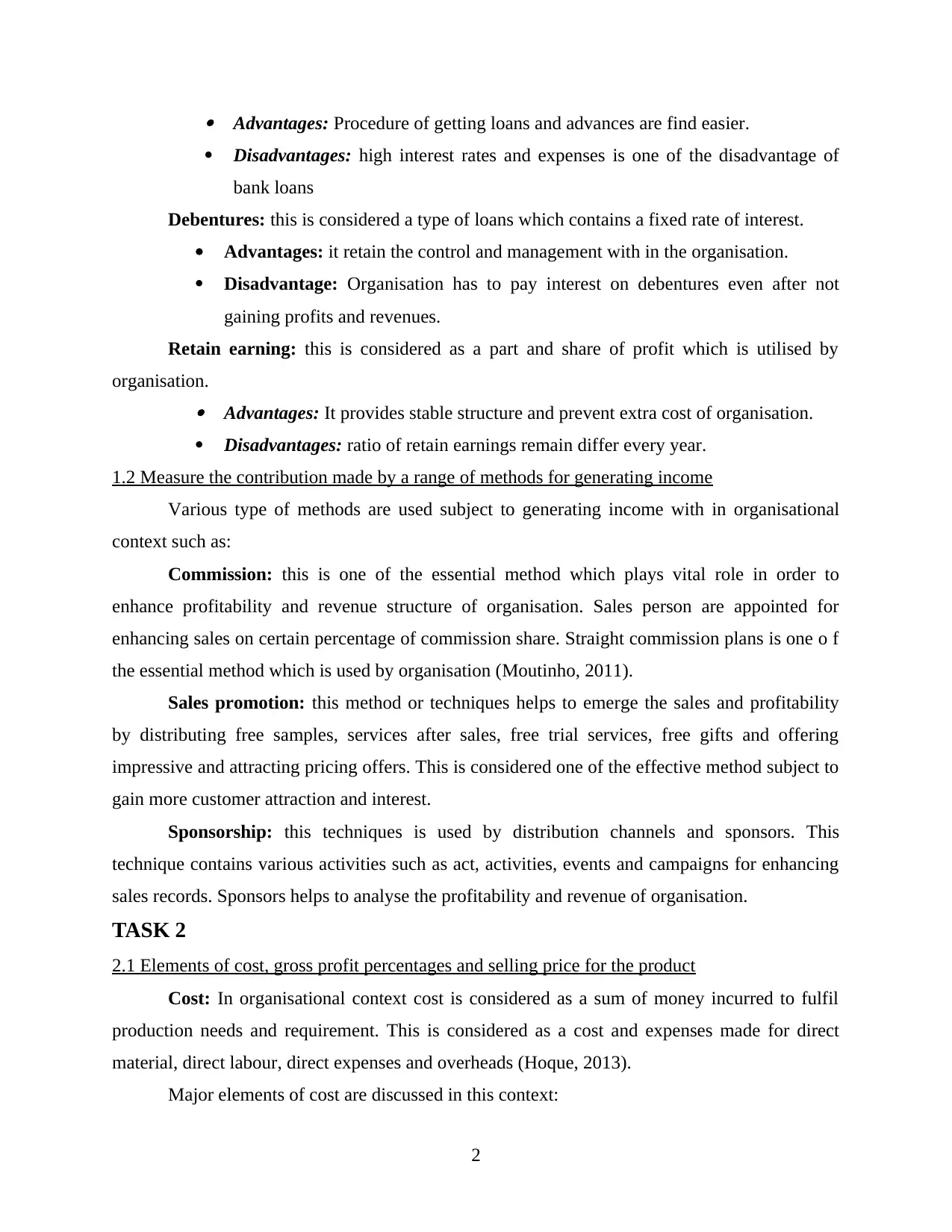
Advantages: Procedure of getting loans and advances are find easier.
Disadvantages: high interest rates and expenses is one of the disadvantage of
bank loans
Debentures: this is considered a type of loans which contains a fixed rate of interest.
Advantages: it retain the control and management with in the organisation.
Disadvantage: Organisation has to pay interest on debentures even after not
gaining profits and revenues.
Retain earning: this is considered as a part and share of profit which is utilised by
organisation.
Advantages: It provides stable structure and prevent extra cost of organisation.
Disadvantages: ratio of retain earnings remain differ every year.
1.2 Measure the contribution made by a range of methods for generating income
Various type of methods are used subject to generating income with in organisational
context such as:
Commission: this is one of the essential method which plays vital role in order to
enhance profitability and revenue structure of organisation. Sales person are appointed for
enhancing sales on certain percentage of commission share. Straight commission plans is one o f
the essential method which is used by organisation (Moutinho, 2011).
Sales promotion: this method or techniques helps to emerge the sales and profitability
by distributing free samples, services after sales, free trial services, free gifts and offering
impressive and attracting pricing offers. This is considered one of the effective method subject to
gain more customer attraction and interest.
Sponsorship: this techniques is used by distribution channels and sponsors. This
technique contains various activities such as act, activities, events and campaigns for enhancing
sales records. Sponsors helps to analyse the profitability and revenue of organisation.
TASK 2
2.1 Elements of cost, gross profit percentages and selling price for the product
Cost: In organisational context cost is considered as a sum of money incurred to fulfil
production needs and requirement. This is considered as a cost and expenses made for direct
material, direct labour, direct expenses and overheads (Hoque, 2013).
Major elements of cost are discussed in this context:
2
Disadvantages: high interest rates and expenses is one of the disadvantage of
bank loans
Debentures: this is considered a type of loans which contains a fixed rate of interest.
Advantages: it retain the control and management with in the organisation.
Disadvantage: Organisation has to pay interest on debentures even after not
gaining profits and revenues.
Retain earning: this is considered as a part and share of profit which is utilised by
organisation.
Advantages: It provides stable structure and prevent extra cost of organisation.
Disadvantages: ratio of retain earnings remain differ every year.
1.2 Measure the contribution made by a range of methods for generating income
Various type of methods are used subject to generating income with in organisational
context such as:
Commission: this is one of the essential method which plays vital role in order to
enhance profitability and revenue structure of organisation. Sales person are appointed for
enhancing sales on certain percentage of commission share. Straight commission plans is one o f
the essential method which is used by organisation (Moutinho, 2011).
Sales promotion: this method or techniques helps to emerge the sales and profitability
by distributing free samples, services after sales, free trial services, free gifts and offering
impressive and attracting pricing offers. This is considered one of the effective method subject to
gain more customer attraction and interest.
Sponsorship: this techniques is used by distribution channels and sponsors. This
technique contains various activities such as act, activities, events and campaigns for enhancing
sales records. Sponsors helps to analyse the profitability and revenue of organisation.
TASK 2
2.1 Elements of cost, gross profit percentages and selling price for the product
Cost: In organisational context cost is considered as a sum of money incurred to fulfil
production needs and requirement. This is considered as a cost and expenses made for direct
material, direct labour, direct expenses and overheads (Hoque, 2013).
Major elements of cost are discussed in this context:
2
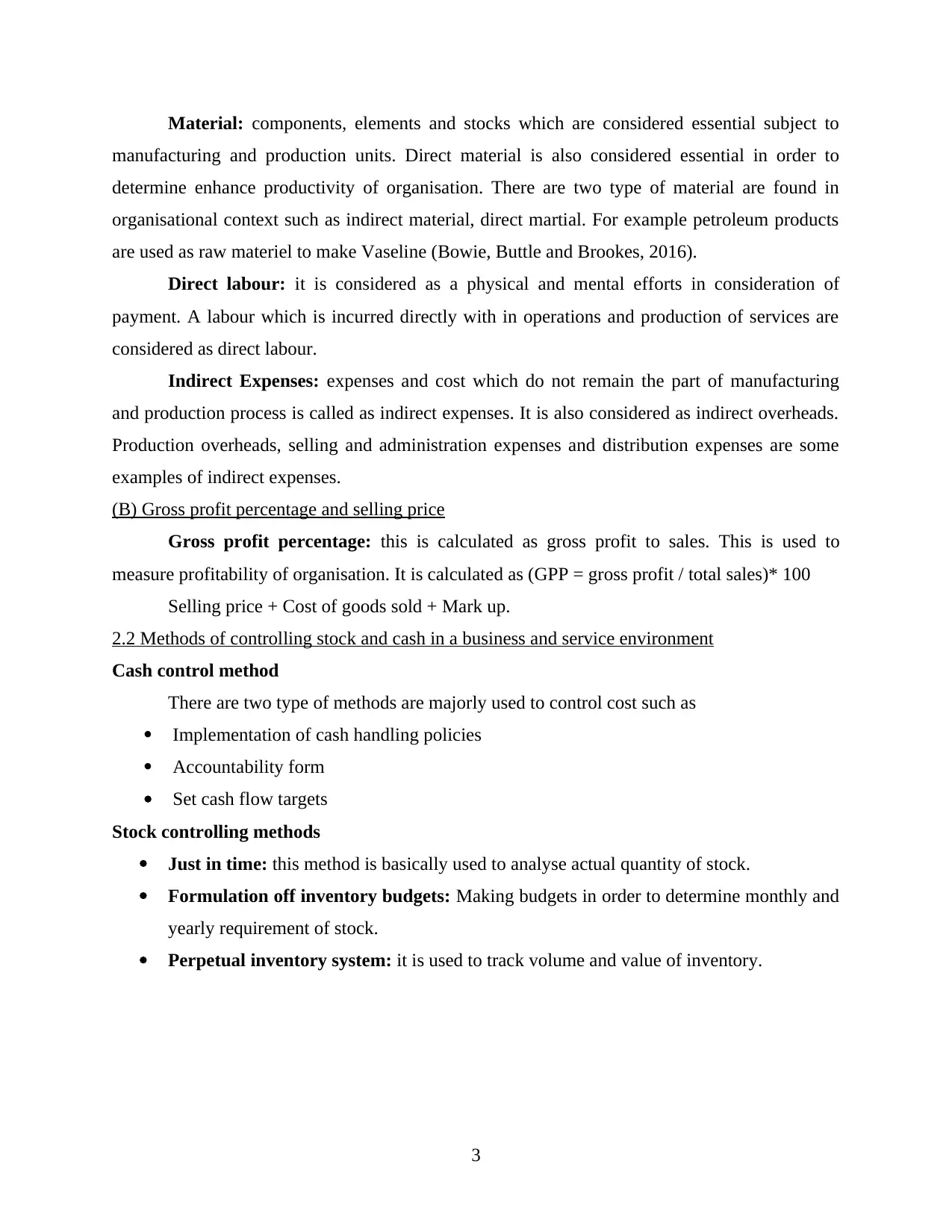
Material: components, elements and stocks which are considered essential subject to
manufacturing and production units. Direct material is also considered essential in order to
determine enhance productivity of organisation. There are two type of material are found in
organisational context such as indirect material, direct martial. For example petroleum products
are used as raw materiel to make Vaseline (Bowie, Buttle and Brookes, 2016).
Direct labour: it is considered as a physical and mental efforts in consideration of
payment. A labour which is incurred directly with in operations and production of services are
considered as direct labour.
Indirect Expenses: expenses and cost which do not remain the part of manufacturing
and production process is called as indirect expenses. It is also considered as indirect overheads.
Production overheads, selling and administration expenses and distribution expenses are some
examples of indirect expenses.
(B) Gross profit percentage and selling price
Gross profit percentage: this is calculated as gross profit to sales. This is used to
measure profitability of organisation. It is calculated as (GPP = gross profit / total sales)* 100
Selling price + Cost of goods sold + Mark up.
2.2 Methods of controlling stock and cash in a business and service environment
Cash control method
There are two type of methods are majorly used to control cost such as
Implementation of cash handling policies
Accountability form
Set cash flow targets
Stock controlling methods
Just in time: this method is basically used to analyse actual quantity of stock.
Formulation off inventory budgets: Making budgets in order to determine monthly and
yearly requirement of stock.
Perpetual inventory system: it is used to track volume and value of inventory.
3
manufacturing and production units. Direct material is also considered essential in order to
determine enhance productivity of organisation. There are two type of material are found in
organisational context such as indirect material, direct martial. For example petroleum products
are used as raw materiel to make Vaseline (Bowie, Buttle and Brookes, 2016).
Direct labour: it is considered as a physical and mental efforts in consideration of
payment. A labour which is incurred directly with in operations and production of services are
considered as direct labour.
Indirect Expenses: expenses and cost which do not remain the part of manufacturing
and production process is called as indirect expenses. It is also considered as indirect overheads.
Production overheads, selling and administration expenses and distribution expenses are some
examples of indirect expenses.
(B) Gross profit percentage and selling price
Gross profit percentage: this is calculated as gross profit to sales. This is used to
measure profitability of organisation. It is calculated as (GPP = gross profit / total sales)* 100
Selling price + Cost of goods sold + Mark up.
2.2 Methods of controlling stock and cash in a business and service environment
Cash control method
There are two type of methods are majorly used to control cost such as
Implementation of cash handling policies
Accountability form
Set cash flow targets
Stock controlling methods
Just in time: this method is basically used to analyse actual quantity of stock.
Formulation off inventory budgets: Making budgets in order to determine monthly and
yearly requirement of stock.
Perpetual inventory system: it is used to track volume and value of inventory.
3
⊘ This is a preview!⊘
Do you want full access?
Subscribe today to unlock all pages.

Trusted by 1+ million students worldwide
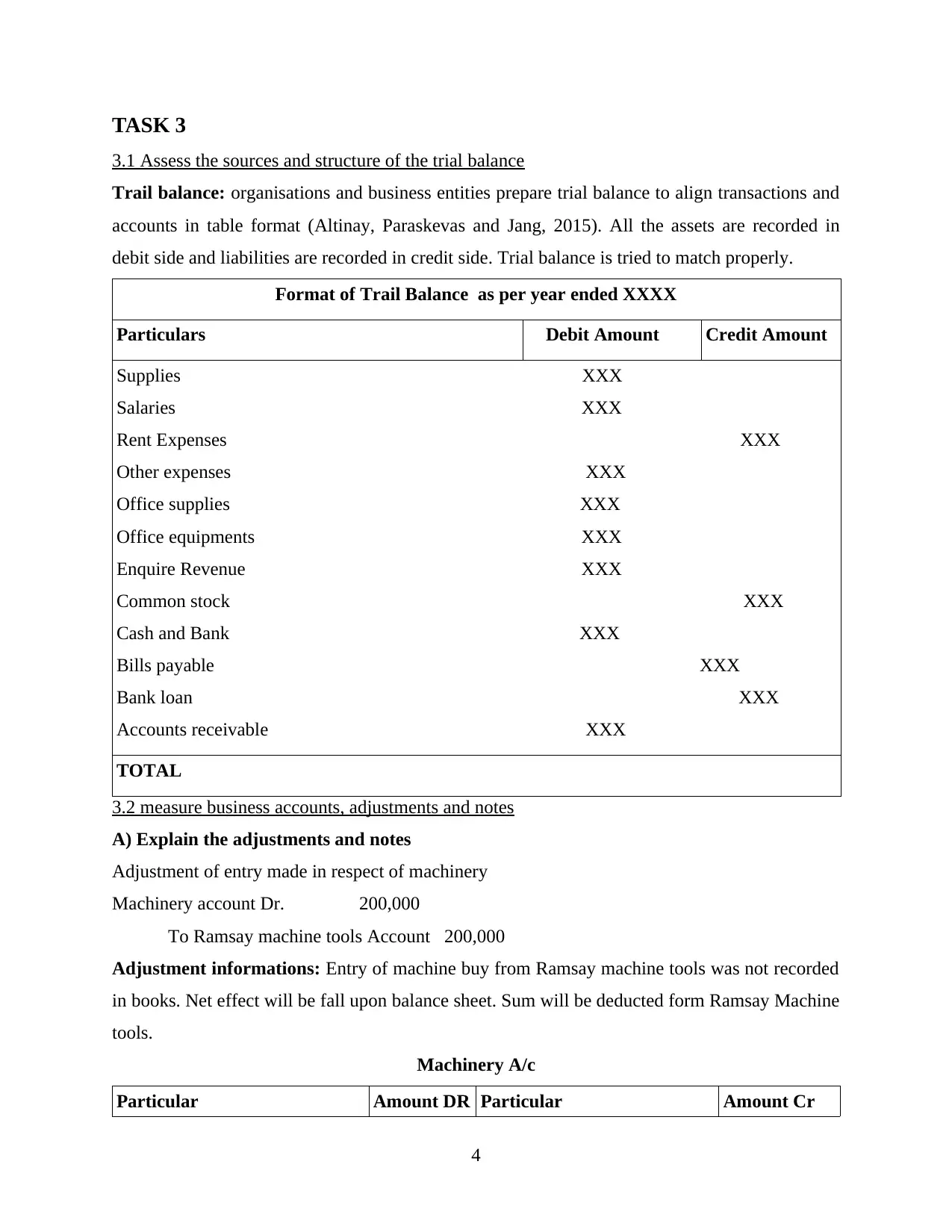
TASK 3
3.1 Assess the sources and structure of the trial balance
Trail balance: organisations and business entities prepare trial balance to align transactions and
accounts in table format (Altinay, Paraskevas and Jang, 2015). All the assets are recorded in
debit side and liabilities are recorded in credit side. Trial balance is tried to match properly.
Format of Trail Balance as per year ended XXXX
Particulars Debit Amount Credit Amount
Supplies XXX
Salaries XXX
Rent Expenses XXX
Other expenses XXX
Office supplies XXX
Office equipments XXX
Enquire Revenue XXX
Common stock XXX
Cash and Bank XXX
Bills payable XXX
Bank loan XXX
Accounts receivable XXX
TOTAL
3.2 measure business accounts, adjustments and notes
A) Explain the adjustments and notes
Adjustment of entry made in respect of machinery
Machinery account Dr. 200,000
To Ramsay machine tools Account 200,000
Adjustment informations: Entry of machine buy from Ramsay machine tools was not recorded
in books. Net effect will be fall upon balance sheet. Sum will be deducted form Ramsay Machine
tools.
Machinery A/c
Particular Amount DR Particular Amount Cr
4
3.1 Assess the sources and structure of the trial balance
Trail balance: organisations and business entities prepare trial balance to align transactions and
accounts in table format (Altinay, Paraskevas and Jang, 2015). All the assets are recorded in
debit side and liabilities are recorded in credit side. Trial balance is tried to match properly.
Format of Trail Balance as per year ended XXXX
Particulars Debit Amount Credit Amount
Supplies XXX
Salaries XXX
Rent Expenses XXX
Other expenses XXX
Office supplies XXX
Office equipments XXX
Enquire Revenue XXX
Common stock XXX
Cash and Bank XXX
Bills payable XXX
Bank loan XXX
Accounts receivable XXX
TOTAL
3.2 measure business accounts, adjustments and notes
A) Explain the adjustments and notes
Adjustment of entry made in respect of machinery
Machinery account Dr. 200,000
To Ramsay machine tools Account 200,000
Adjustment informations: Entry of machine buy from Ramsay machine tools was not recorded
in books. Net effect will be fall upon balance sheet. Sum will be deducted form Ramsay Machine
tools.
Machinery A/c
Particular Amount DR Particular Amount Cr
4
Paraphrase This Document
Need a fresh take? Get an instant paraphrase of this document with our AI Paraphraser
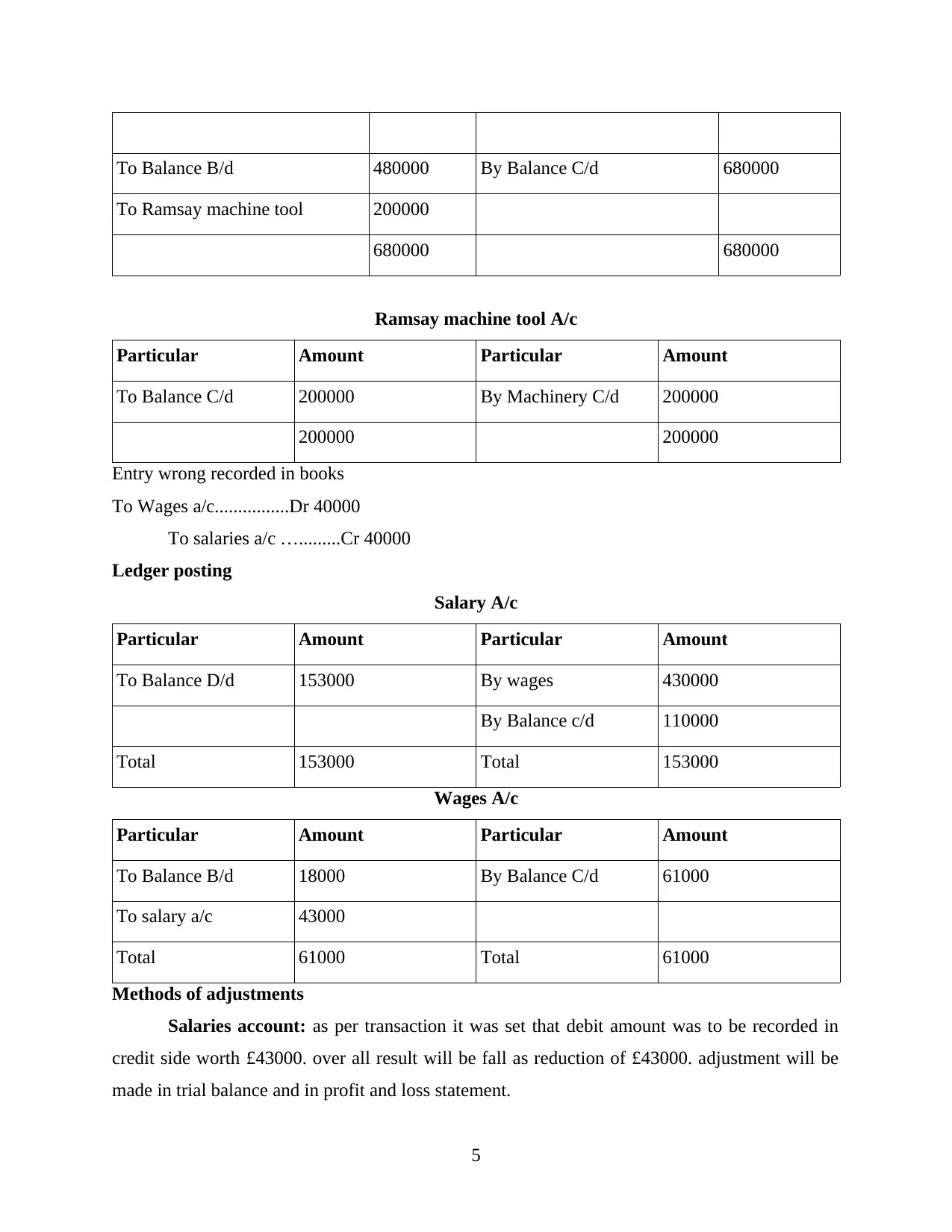
To Balance B/d 480000 By Balance C/d 680000
To Ramsay machine tool 200000
680000 680000
Ramsay machine tool A/c
Particular Amount Particular Amount
To Balance C/d 200000 By Machinery C/d 200000
200000 200000
Entry wrong recorded in books
To Wages a/c................Dr 40000
To salaries a/c ….........Cr 40000
Ledger posting
Salary A/c
Particular Amount Particular Amount
To Balance D/d 153000 By wages 430000
By Balance c/d 110000
Total 153000 Total 153000
Wages A/c
Particular Amount Particular Amount
To Balance B/d 18000 By Balance C/d 61000
To salary a/c 43000
Total 61000 Total 61000
Methods of adjustments
Salaries account: as per transaction it was set that debit amount was to be recorded in
credit side worth £43000. over all result will be fall as reduction of £43000. adjustment will be
made in trial balance and in profit and loss statement.
5
To Ramsay machine tool 200000
680000 680000
Ramsay machine tool A/c
Particular Amount Particular Amount
To Balance C/d 200000 By Machinery C/d 200000
200000 200000
Entry wrong recorded in books
To Wages a/c................Dr 40000
To salaries a/c ….........Cr 40000
Ledger posting
Salary A/c
Particular Amount Particular Amount
To Balance D/d 153000 By wages 430000
By Balance c/d 110000
Total 153000 Total 153000
Wages A/c
Particular Amount Particular Amount
To Balance B/d 18000 By Balance C/d 61000
To salary a/c 43000
Total 61000 Total 61000
Methods of adjustments
Salaries account: as per transaction it was set that debit amount was to be recorded in
credit side worth £43000. over all result will be fall as reduction of £43000. adjustment will be
made in trial balance and in profit and loss statement.
5
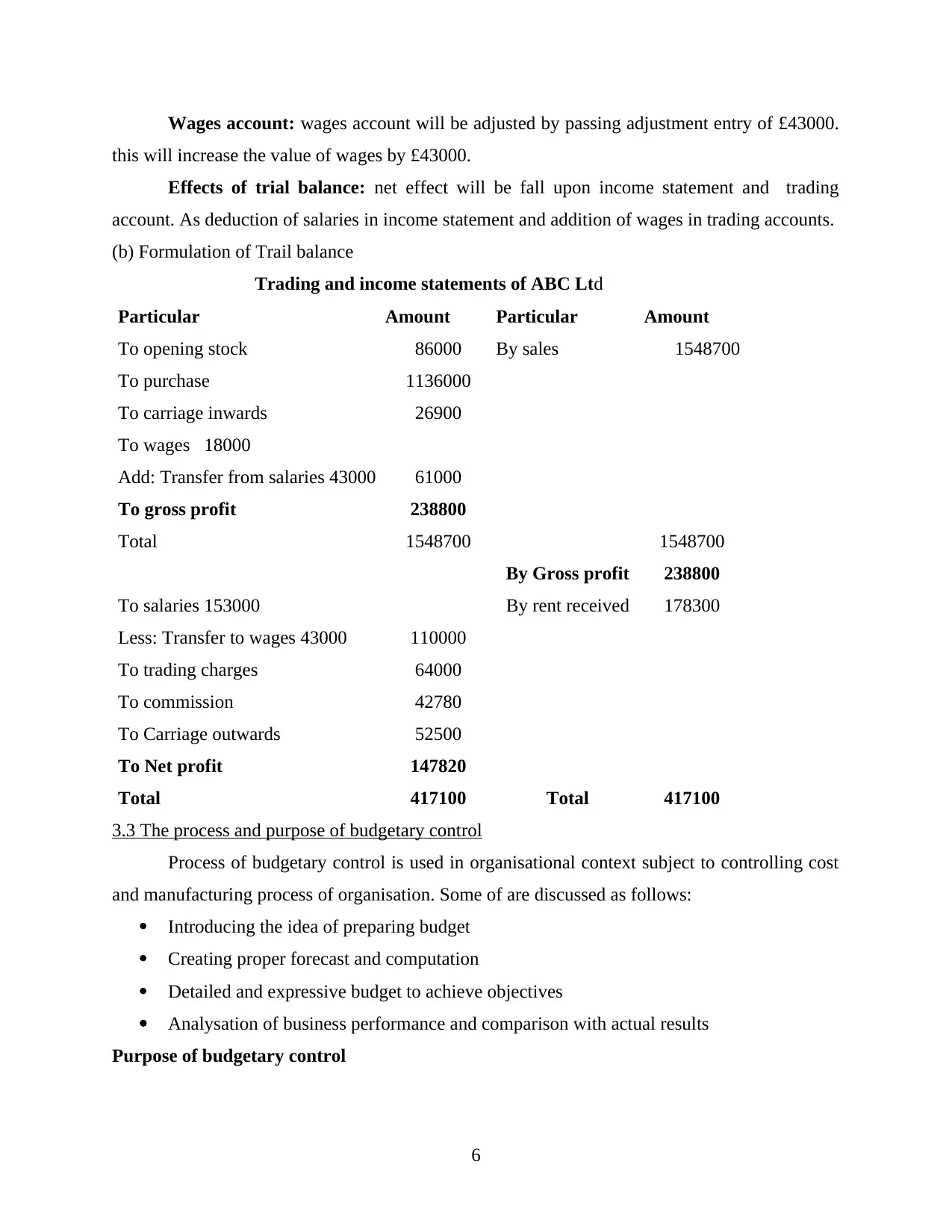
Wages account: wages account will be adjusted by passing adjustment entry of £43000.
this will increase the value of wages by £43000.
Effects of trial balance: net effect will be fall upon income statement and trading
account. As deduction of salaries in income statement and addition of wages in trading accounts.
(b) Formulation of Trail balance
Trading and income statements of ABC Ltd
Particular Amount Particular Amount
To opening stock 86000 By sales 1548700
To purchase 1136000
To carriage inwards 26900
To wages 18000
Add: Transfer from salaries 43000 61000
To gross profit 238800
Total 1548700 1548700
By Gross profit 238800
To salaries 153000 By rent received 178300
Less: Transfer to wages 43000 110000
To trading charges 64000
To commission 42780
To Carriage outwards 52500
To Net profit 147820
Total 417100 Total 417100
3.3 The process and purpose of budgetary control
Process of budgetary control is used in organisational context subject to controlling cost
and manufacturing process of organisation. Some of are discussed as follows:
Introducing the idea of preparing budget
Creating proper forecast and computation
Detailed and expressive budget to achieve objectives
Analysation of business performance and comparison with actual results
Purpose of budgetary control
6
this will increase the value of wages by £43000.
Effects of trial balance: net effect will be fall upon income statement and trading
account. As deduction of salaries in income statement and addition of wages in trading accounts.
(b) Formulation of Trail balance
Trading and income statements of ABC Ltd
Particular Amount Particular Amount
To opening stock 86000 By sales 1548700
To purchase 1136000
To carriage inwards 26900
To wages 18000
Add: Transfer from salaries 43000 61000
To gross profit 238800
Total 1548700 1548700
By Gross profit 238800
To salaries 153000 By rent received 178300
Less: Transfer to wages 43000 110000
To trading charges 64000
To commission 42780
To Carriage outwards 52500
To Net profit 147820
Total 417100 Total 417100
3.3 The process and purpose of budgetary control
Process of budgetary control is used in organisational context subject to controlling cost
and manufacturing process of organisation. Some of are discussed as follows:
Introducing the idea of preparing budget
Creating proper forecast and computation
Detailed and expressive budget to achieve objectives
Analysation of business performance and comparison with actual results
Purpose of budgetary control
6
⊘ This is a preview!⊘
Do you want full access?
Subscribe today to unlock all pages.

Trusted by 1+ million students worldwide
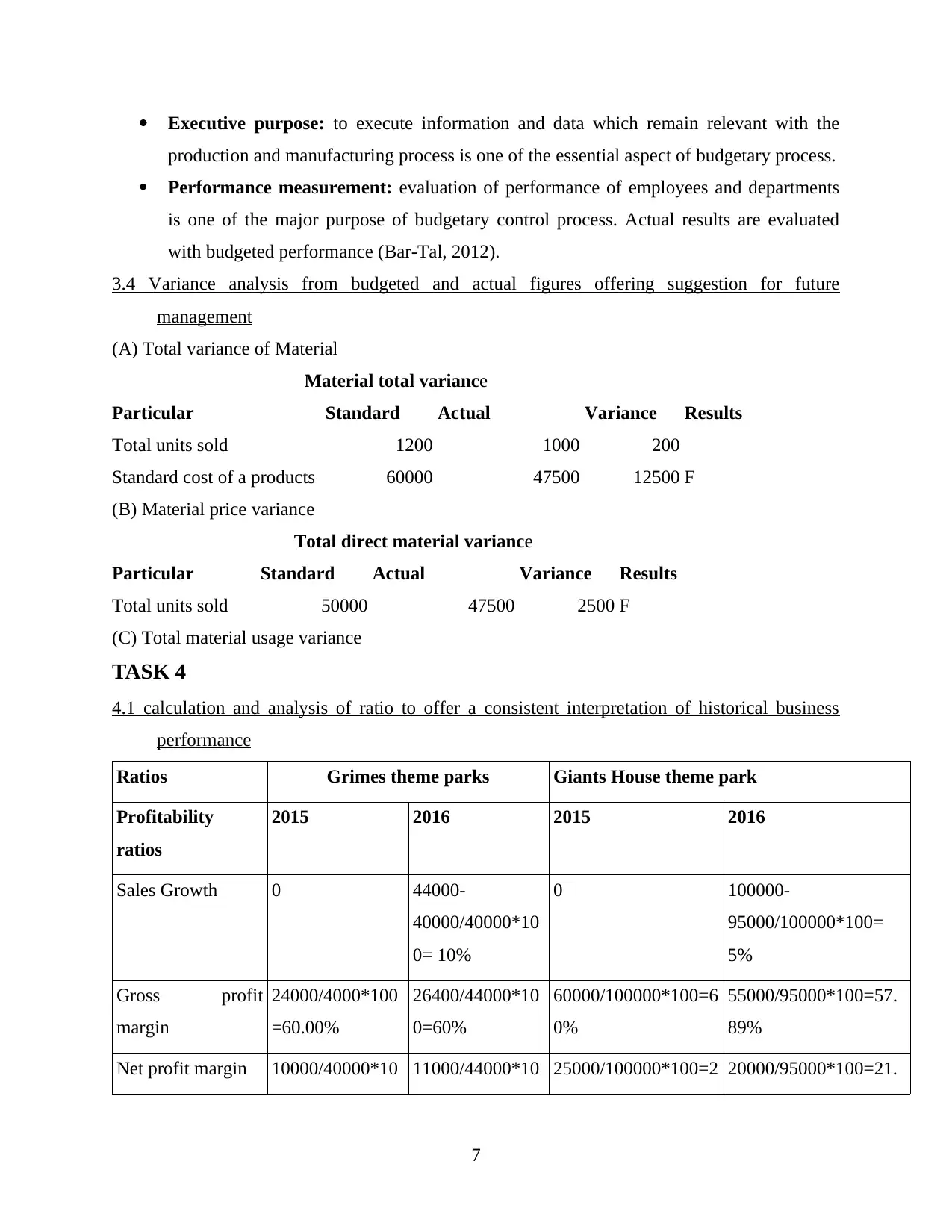
Executive purpose: to execute information and data which remain relevant with the
production and manufacturing process is one of the essential aspect of budgetary process.
Performance measurement: evaluation of performance of employees and departments
is one of the major purpose of budgetary control process. Actual results are evaluated
with budgeted performance (Bar-Tal, 2012).
3.4 Variance analysis from budgeted and actual figures offering suggestion for future
management
(A) Total variance of Material
Material total variance
Particular Standard Actual Variance Results
Total units sold 1200 1000 200
Standard cost of a products 60000 47500 12500 F
(B) Material price variance
Total direct material variance
Particular Standard Actual Variance Results
Total units sold 50000 47500 2500 F
(C) Total material usage variance
TASK 4
4.1 calculation and analysis of ratio to offer a consistent interpretation of historical business
performance
Ratios Grimes theme parks Giants House theme park
Profitability
ratios
2015 2016 2015 2016
Sales Growth 0 44000-
40000/40000*10
0= 10%
0 100000-
95000/100000*100=
5%
Gross profit
margin
24000/4000*100
=60.00%
26400/44000*10
0=60%
60000/100000*100=6
0%
55000/95000*100=57.
89%
Net profit margin 10000/40000*10 11000/44000*10 25000/100000*100=2 20000/95000*100=21.
7
production and manufacturing process is one of the essential aspect of budgetary process.
Performance measurement: evaluation of performance of employees and departments
is one of the major purpose of budgetary control process. Actual results are evaluated
with budgeted performance (Bar-Tal, 2012).
3.4 Variance analysis from budgeted and actual figures offering suggestion for future
management
(A) Total variance of Material
Material total variance
Particular Standard Actual Variance Results
Total units sold 1200 1000 200
Standard cost of a products 60000 47500 12500 F
(B) Material price variance
Total direct material variance
Particular Standard Actual Variance Results
Total units sold 50000 47500 2500 F
(C) Total material usage variance
TASK 4
4.1 calculation and analysis of ratio to offer a consistent interpretation of historical business
performance
Ratios Grimes theme parks Giants House theme park
Profitability
ratios
2015 2016 2015 2016
Sales Growth 0 44000-
40000/40000*10
0= 10%
0 100000-
95000/100000*100=
5%
Gross profit
margin
24000/4000*100
=60.00%
26400/44000*10
0=60%
60000/100000*100=6
0%
55000/95000*100=57.
89%
Net profit margin 10000/40000*10 11000/44000*10 25000/100000*100=2 20000/95000*100=21.
7
Paraphrase This Document
Need a fresh take? Get an instant paraphrase of this document with our AI Paraphraser
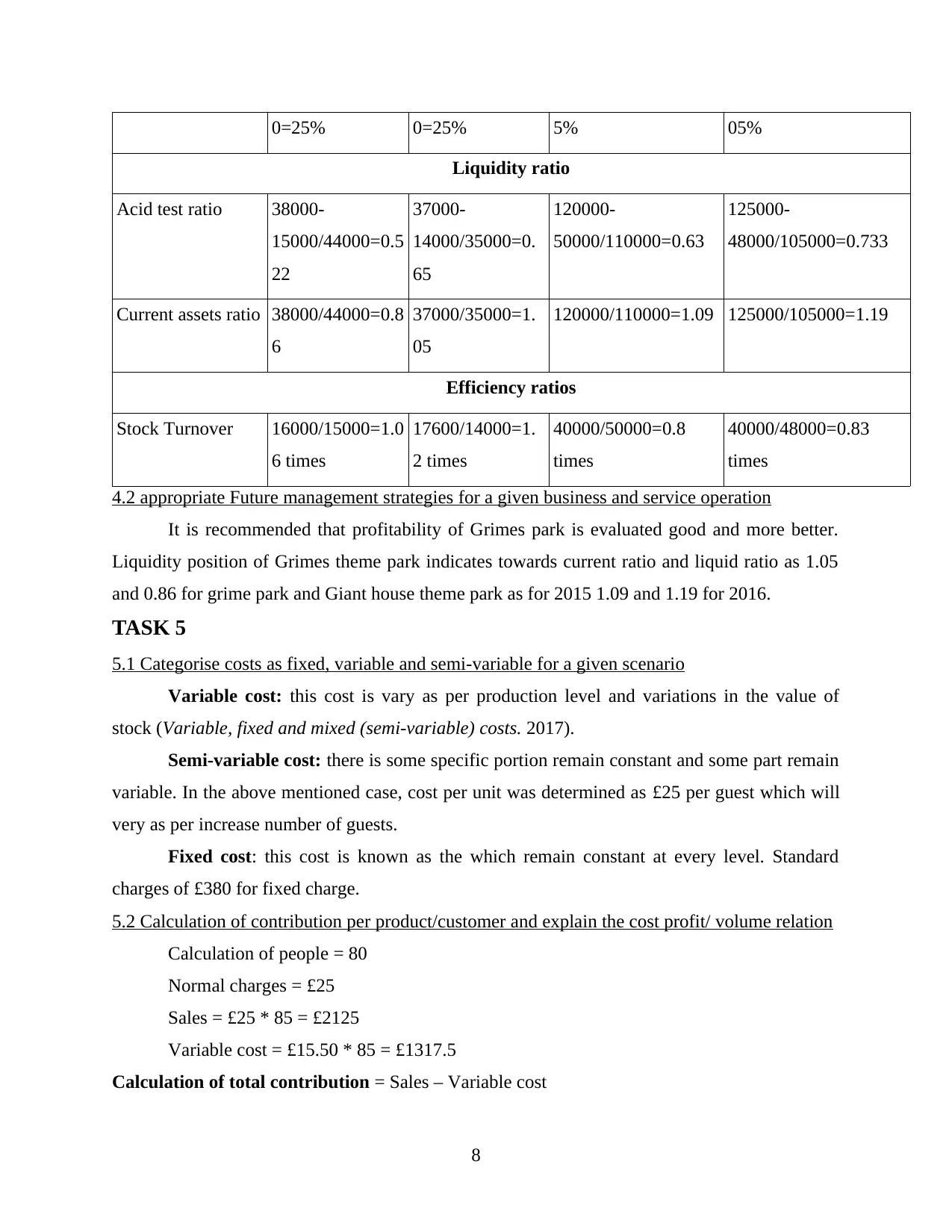
0=25% 0=25% 5% 05%
Liquidity ratio
Acid test ratio 38000-
15000/44000=0.5
22
37000-
14000/35000=0.
65
120000-
50000/110000=0.63
125000-
48000/105000=0.733
Current assets ratio 38000/44000=0.8
6
37000/35000=1.
05
120000/110000=1.09 125000/105000=1.19
Efficiency ratios
Stock Turnover 16000/15000=1.0
6 times
17600/14000=1.
2 times
40000/50000=0.8
times
40000/48000=0.83
times
4.2 appropriate Future management strategies for a given business and service operation
It is recommended that profitability of Grimes park is evaluated good and more better.
Liquidity position of Grimes theme park indicates towards current ratio and liquid ratio as 1.05
and 0.86 for grime park and Giant house theme park as for 2015 1.09 and 1.19 for 2016.
TASK 5
5.1 Categorise costs as fixed, variable and semi-variable for a given scenario
Variable cost: this cost is vary as per production level and variations in the value of
stock (Variable, fixed and mixed (semi-variable) costs. 2017).
Semi-variable cost: there is some specific portion remain constant and some part remain
variable. In the above mentioned case, cost per unit was determined as £25 per guest which will
very as per increase number of guests.
Fixed cost: this cost is known as the which remain constant at every level. Standard
charges of £380 for fixed charge.
5.2 Calculation of contribution per product/customer and explain the cost profit/ volume relation
Calculation of people = 80
Normal charges = £25
Sales = £25 * 85 = £2125
Variable cost = £15.50 * 85 = £1317.5
Calculation of total contribution = Sales – Variable cost
8
Liquidity ratio
Acid test ratio 38000-
15000/44000=0.5
22
37000-
14000/35000=0.
65
120000-
50000/110000=0.63
125000-
48000/105000=0.733
Current assets ratio 38000/44000=0.8
6
37000/35000=1.
05
120000/110000=1.09 125000/105000=1.19
Efficiency ratios
Stock Turnover 16000/15000=1.0
6 times
17600/14000=1.
2 times
40000/50000=0.8
times
40000/48000=0.83
times
4.2 appropriate Future management strategies for a given business and service operation
It is recommended that profitability of Grimes park is evaluated good and more better.
Liquidity position of Grimes theme park indicates towards current ratio and liquid ratio as 1.05
and 0.86 for grime park and Giant house theme park as for 2015 1.09 and 1.19 for 2016.
TASK 5
5.1 Categorise costs as fixed, variable and semi-variable for a given scenario
Variable cost: this cost is vary as per production level and variations in the value of
stock (Variable, fixed and mixed (semi-variable) costs. 2017).
Semi-variable cost: there is some specific portion remain constant and some part remain
variable. In the above mentioned case, cost per unit was determined as £25 per guest which will
very as per increase number of guests.
Fixed cost: this cost is known as the which remain constant at every level. Standard
charges of £380 for fixed charge.
5.2 Calculation of contribution per product/customer and explain the cost profit/ volume relation
Calculation of people = 80
Normal charges = £25
Sales = £25 * 85 = £2125
Variable cost = £15.50 * 85 = £1317.5
Calculation of total contribution = Sales – Variable cost
8
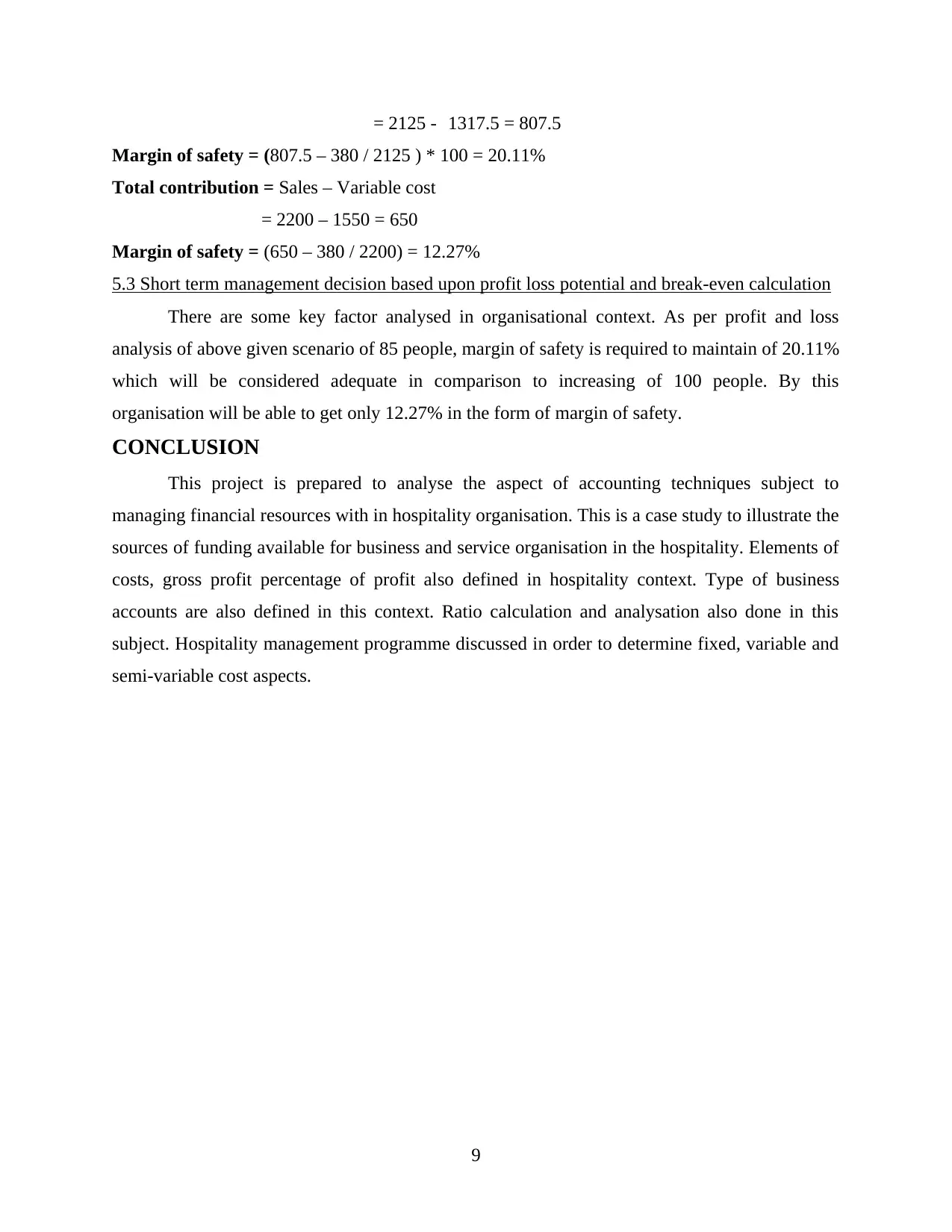
= 2125 - 1317.5 = 807.5
Margin of safety = (807.5 – 380 / 2125 ) * 100 = 20.11%
Total contribution = Sales – Variable cost
= 2200 – 1550 = 650
Margin of safety = (650 – 380 / 2200) = 12.27%
5.3 Short term management decision based upon profit loss potential and break-even calculation
There are some key factor analysed in organisational context. As per profit and loss
analysis of above given scenario of 85 people, margin of safety is required to maintain of 20.11%
which will be considered adequate in comparison to increasing of 100 people. By this
organisation will be able to get only 12.27% in the form of margin of safety.
CONCLUSION
This project is prepared to analyse the aspect of accounting techniques subject to
managing financial resources with in hospitality organisation. This is a case study to illustrate the
sources of funding available for business and service organisation in the hospitality. Elements of
costs, gross profit percentage of profit also defined in hospitality context. Type of business
accounts are also defined in this context. Ratio calculation and analysation also done in this
subject. Hospitality management programme discussed in order to determine fixed, variable and
semi-variable cost aspects.
9
Margin of safety = (807.5 – 380 / 2125 ) * 100 = 20.11%
Total contribution = Sales – Variable cost
= 2200 – 1550 = 650
Margin of safety = (650 – 380 / 2200) = 12.27%
5.3 Short term management decision based upon profit loss potential and break-even calculation
There are some key factor analysed in organisational context. As per profit and loss
analysis of above given scenario of 85 people, margin of safety is required to maintain of 20.11%
which will be considered adequate in comparison to increasing of 100 people. By this
organisation will be able to get only 12.27% in the form of margin of safety.
CONCLUSION
This project is prepared to analyse the aspect of accounting techniques subject to
managing financial resources with in hospitality organisation. This is a case study to illustrate the
sources of funding available for business and service organisation in the hospitality. Elements of
costs, gross profit percentage of profit also defined in hospitality context. Type of business
accounts are also defined in this context. Ratio calculation and analysation also done in this
subject. Hospitality management programme discussed in order to determine fixed, variable and
semi-variable cost aspects.
9
⊘ This is a preview!⊘
Do you want full access?
Subscribe today to unlock all pages.

Trusted by 1+ million students worldwide
1 out of 12
Related Documents
Your All-in-One AI-Powered Toolkit for Academic Success.
+13062052269
info@desklib.com
Available 24*7 on WhatsApp / Email
![[object Object]](/_next/static/media/star-bottom.7253800d.svg)
Unlock your academic potential
Copyright © 2020–2025 A2Z Services. All Rights Reserved. Developed and managed by ZUCOL.





